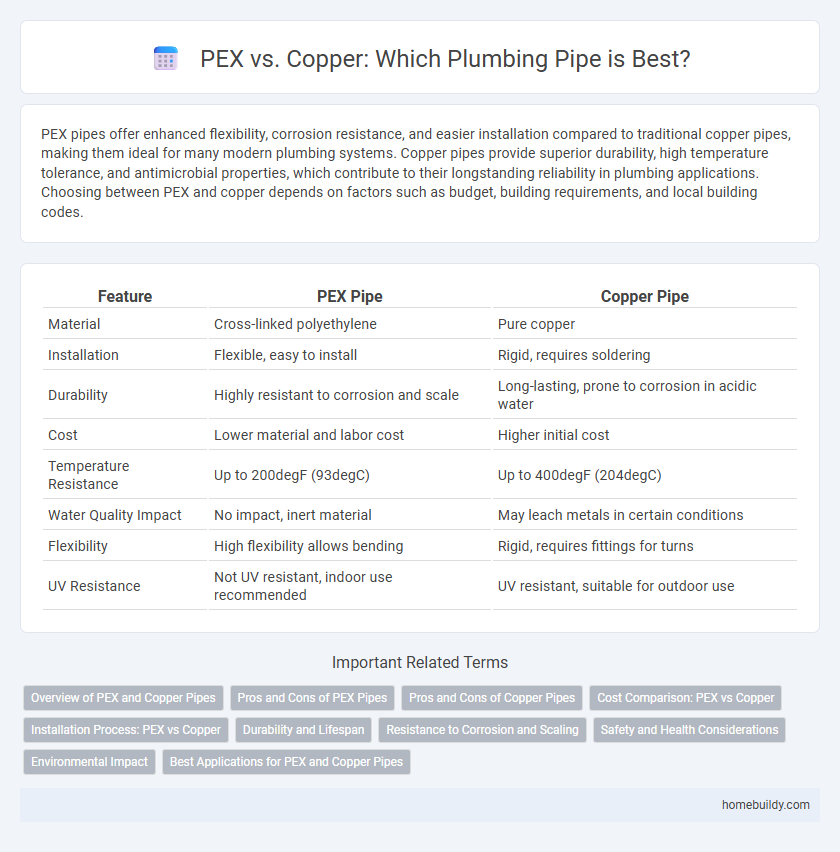PEX pipes offer enhanced flexibility, corrosion resistance, and easier installation compared to traditional copper pipes, making them ideal for many modern plumbing systems. Copper pipes provide superior durability, high temperature tolerance, and antimicrobial properties, which contribute to their longstanding reliability in plumbing applications. Choosing between PEX and copper depends on factors such as budget, building requirements, and local building codes.
Table of Comparison
| Feature | PEX Pipe | Copper Pipe |
|---|---|---|
| Material | Cross-linked polyethylene | Pure copper |
| Installation | Flexible, easy to install | Rigid, requires soldering |
| Durability | Highly resistant to corrosion and scale | Long-lasting, prone to corrosion in acidic water |
| Cost | Lower material and labor cost | Higher initial cost |
| Temperature Resistance | Up to 200degF (93degC) | Up to 400degF (204degC) |
| Water Quality Impact | No impact, inert material | May leach metals in certain conditions |
| Flexibility | High flexibility allows bending | Rigid, requires fittings for turns |
| UV Resistance | Not UV resistant, indoor use recommended | UV resistant, suitable for outdoor use |
Overview of PEX and Copper Pipes
PEX pipes, made from cross-linked polyethylene, offer flexible installation, resistance to scale and chlorine, and cost-effectiveness compared to traditional materials. Copper pipes provide durability, high thermal conductivity, and long-lasting resistance to corrosion, making them ideal for high-temperature applications. Both materials serve essential roles in plumbing systems, with PEX favored for ease of use and copper preferred for strength and reliability.
Pros and Cons of PEX Pipes
PEX pipes offer flexibility, resistance to scale and chlorine, and easier installation compared to copper pipes, reducing labor costs and installation time. They are less prone to corrosion and freezing damage but can be susceptible to UV degradation and potential chemical leaching. Despite lower upfront costs and versatility, PEX pipes may not be suitable for outdoor exposure or high-temperature applications where copper excels.
Pros and Cons of Copper Pipes
Copper pipes offer exceptional durability and resistance to high temperatures, making them ideal for hot water supply lines and long-lasting plumbing installations. They are naturally antimicrobial, reducing the risk of bacteria growth, but can be prone to corrosion and may develop pinhole leaks over time in acidic or corrosive water conditions. Copper's higher upfront cost and the need for specialized tools and skills for installation contribute to increased labor expenses compared to PEX piping.
Cost Comparison: PEX vs Copper
PEX plumbing pipes typically cost between $0.50 and $2.00 per linear foot, while copper pipes range from $2.00 to $10.00 per linear foot, making PEX significantly more affordable for both materials and installation. Labor costs for copper are generally higher due to the need for soldering and specialized fittings, whereas PEX uses simpler compression or crimp fittings that reduce installation time and expense. Over the lifespan of a plumbing system, homeowners can save up to 70% on upfront costs by choosing PEX over copper, which also tends to have lower maintenance expenses.
Installation Process: PEX vs Copper
PEX pipes offer a faster and easier installation process compared to copper, requiring fewer fittings and tools due to their flexibility and ability to bend around obstacles. Copper installation demands soldering, cutting, and precise measurements, leading to longer labor times and increased complexity. The simplicity and reduced labor cost of PEX make it a preferred choice for modern plumbing systems in residential and commercial construction.
Durability and Lifespan
PEX plumbing pipes offer excellent durability with resistance to corrosion, scale buildup, and freeze damage, often lasting 40 to 50 years. Copper pipes provide a proven lifespan of 50 years or more due to their natural resistance to bacteria and high temperatures but can be prone to corrosion in acidic or highly alkaline water. Choosing between PEX and copper pipes depends on specific environmental factors and the desired longevity of the plumbing system.
Resistance to Corrosion and Scaling
PEX plumbing pipes exhibit superior resistance to corrosion and scaling compared to copper pipes, making them ideal for water systems prone to mineral buildup. Copper pipes, while durable, are susceptible to corrosion over time, especially in acidic or low pH water conditions, which can lead to leaks and reduced water quality. The non-metallic composition of PEX prevents rust formation and scaling, ensuring longer-lasting plumbing installations and consistent water flow.
Safety and Health Considerations
PEX plumbing pipes feature chlorine resistance and flexibility that reduce the risk of leaks and bacterial growth, enhancing overall water quality and safety for household use. Copper pipes offer natural antimicrobial properties that inhibit harmful bacteria, contributing to healthier water systems in residential plumbing. Both materials comply with strict safety standards, but PEX's resistance to corrosion and scale buildup makes it a preferred choice in preventing water contamination.
Environmental Impact
PEX pipes have a lower environmental impact compared to copper due to their reduced energy consumption during manufacturing and transportation, as they are lightweight and require less heat to produce. Copper extraction and processing generate significant mining waste and greenhouse gas emissions, contributing heavily to environmental degradation. Additionally, PEX pipes are less prone to corrosion and have a longer lifespan in many applications, reducing the need for frequent replacement and waste.
Best Applications for PEX and Copper Pipes
PEX pipes excel in residential water supply systems due to their flexibility, resistance to corrosion, and ease of installation, making them ideal for retrofits and complex layouts. Copper pipes are preferred in commercial and high-temperature applications for their durability, antimicrobial properties, and ability to withstand extreme heat and pressure. Both materials perform well in potable water distribution, but choosing between them depends on factors like budget, local building codes, and specific project requirements.
PEX vs Copper Infographic

 homebuildy.com
homebuildy.com